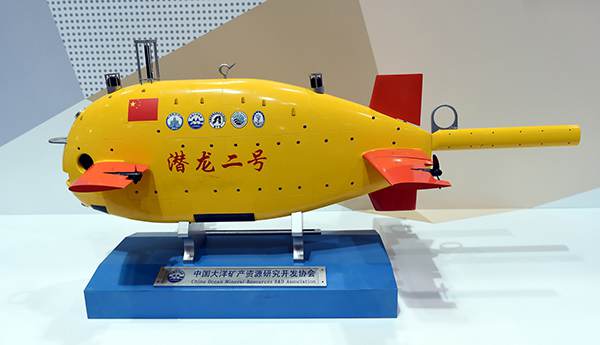


[File photo]
China’s underwater robot technology has advanced significantly in recent years, but the country still faces problems, including a lack of applicable products and relatively slow transformation process from technologies to applicable products, experts said.
In 2016, China’s underwater robot industry saw fast development. In January, the homegrown unmanned autonomous underwater vehicle Qianling-2 accomplished its first undersea mission, searching the seabed and collecting high-precision hydrological data.
In August, Haidou-1, China’s domestic underwater glider, dove over 10,767 meters below sea level, making China the third country after Japan and the U.S. to have built submersibles capable of reaching depths in excess of 10,000 meters.
Though China’s progress in underwater robot technology has been recognized by the international community, the country still lags behind compared to many developed nations. It is time-consuming to transform technologies into actual products, and China still has a long way to go to establish a mature industrial system.
“In the U.S., an underwater robot can be tested hundreds of times per year, while in China we can only test the robot dozens of times [due to the slow process of technological transformation]. In the long run, China will fall even further behind,” Liu Jian, chief designer of Qianling-2, told Economic Information Daily.
Feng Xisheng, an academic at the Chinese Academy of Sciences, pointed out that China needs to build a system covering the research, design, manufacturing, application and talent training of underwater robots. While other countries have established distinct industrial sectors to develop such technologies, underwater robots in China are mainly studied at research centers, with few companies taking part in the process.
Experts believe that favorable policies and a mature system should be established in China to promote its underwater robotics industry, which is crucial for the country’s sustainable development and national security.
 Fire brigade in Shanghai holds group wedding
Fire brigade in Shanghai holds group wedding Tourists enjoy ice sculptures in Datan Town, north China
Tourists enjoy ice sculptures in Datan Town, north China Sunset scenery of Dayan Pagoda in Xi'an
Sunset scenery of Dayan Pagoda in Xi'an Tourists have fun at scenic spot in Nanlong Town, NW China
Tourists have fun at scenic spot in Nanlong Town, NW China Harbin attracts tourists by making best use of ice in winter
Harbin attracts tourists by making best use of ice in winter In pics: FIS Alpine Ski Women's World Cup Slalom
In pics: FIS Alpine Ski Women's World Cup Slalom Black-necked cranes rest at reservoir in Lhunzhub County, Lhasa
Black-necked cranes rest at reservoir in Lhunzhub County, Lhasa China's FAST telescope will be available to foreign scientists in April
China's FAST telescope will be available to foreign scientists in April "She power" plays indispensable role in poverty alleviation
"She power" plays indispensable role in poverty alleviation Top 10 world news events of People's Daily in 2020
Top 10 world news events of People's Daily in 2020 Top 10 China news events of People's Daily in 2020
Top 10 China news events of People's Daily in 2020 Top 10 media buzzwords of 2020
Top 10 media buzzwords of 2020 Year-ender:10 major tourism stories of 2020
Year-ender:10 major tourism stories of 2020 No interference in Venezuelan issues
No interference in Venezuelan issues
 Biz prepares for trade spat
Biz prepares for trade spat
 Broadcasting Continent
Broadcasting Continent Australia wins Chinese CEOs as US loses
Australia wins Chinese CEOs as US loses